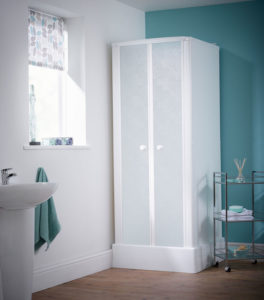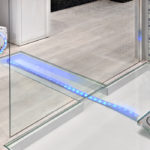Renewing bathrooms in existing homes is a major part of housing refurbishment programmes for local authorities and housing associations. Bathrooms are also an important part of the specification on new-build schemes. Here Ann Boardman, Head of Marketing and Product Development at Saniflo UK, shares her top tips on getting it right first time with shower facilities.
When working on bathroom refurbishment and new-build projects, the main considerations are no doubt cost, disruption, durability and product suitability for all ages and physical abilities. The first thing specifiers need to do is carefully consider the choice of product. My advice is to opt for shower cubicles rather than shower enclosures as they are more economically viable long-term for social housing providers, and also a good option for residents too.
The Kinedo range of shower cubicles from Saniflo, for example, can be up and running in less than a day with minimum disruption to the bathroom and residents, as there’s no need for tiling, grout or silicone. For refurbishment projects, Kinedo Kinemagic slots into the place where the old bath was, making the installation process straightforward. All shower cubicles in the range are designed with inclusivity in mind, which means they are safe and easy for everyone to use, with certain models featuring grab rails, seats and thermostatic showers catering for less mobile individuals.
Timber frame
An increasing number of new-build properties are built using timber frame. Timber frame buildings require special considerations, especially when it comes to the bathrooms, and in particular showers. Timber changes naturally over time and can shift and warp, causing movement to the building. In the event of warping, traditional shower enclosures with tiles can be prone to cracking; meaning the enclosure is no longer watertight and more likely to leak. This is why in timber frame constructions it is advisable to consider showers that do not require tiling, grout or silicone.
If water finds its way into a building’s timber frame it can cause damp and rot, which will jeopardise the structural integrity in the bathroom at the very least. Spores from rot are also a health hazard. For timber frame buildings, the safer option might well be a shower cubicle. With integrated internal panels that move with the building there is little risk of a leak.
 Easy installation
Easy installation
North View Housing installed 13 Consort cubicles from the Saniflo Kinedo range to upgrade bathrooms in a number of its properties. Installer Jim Girdwood comments: “These units are very straightforward to install — we have a working, leak free shower up and running in under half a day. I’ve fitted many of these now and they are really a great choice for these properties — with no tiling or grouting and no silicone required they are practical and modern in style. With a single piece interior and the lightweight doors, it slots together very simply.”
River Clyde Homes specified the Saniflo Sanifloor shower pumps to facilitate a downstairs shower in 13 new homes, which will be installed in the event of a tenant becoming immobile. Jim Tedford, Site Manager, says: “Using the Sanifloor pumps saved us digging the floors back up to install new water pipes that may — or may not — be used in future to take water waste from a shower. It was a good idea to add the infrastructure in case tenants need a downstairs shower due to immobility issues and plumbing in the pumps was very straightforward and cost-effective.”
When selecting showers for refurbishment and new-build projects, it is important local authorities and housing associations choose the right partner, such as a company which designs, manufactures and tests in Europe. A supply chain partner with complete control over the process can maintain the highest standards of quality and service.









